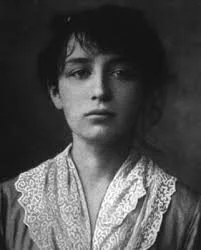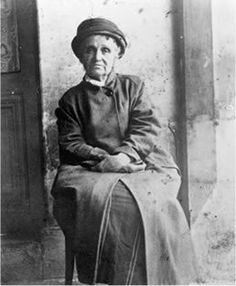The story of Camille Claudel is one of heartbreak and sadness. A genius of an artist she never got her due and ended her life alone.
Born on December 8, 1864 to Louis Prosper Claudel and Louise Athanaise in Fère-en-Tardenois in the Aisne department. The oldest child of three, later they would have Paul in 1868 and Louise in 1866. At just 12 years old she began to play with clay and her talent got the attention of artist Alfred Boucher. Her father supported her pursuit and agreed to move to Paris so she would be able to study under Boucher. Her mother on the other hand did not and never would support her.
In 1882, when she was 18 she rented a studio at 117 Rue Notre-Dame des Champs, giving it another forty years and she could have been neighbors with Ernest and Hadley Hemingway. Working each day with a group of female artists under the guidance of Boucher until he left for Rome. Winning the Salon prize, he went to Rome and asked his friend and fellow sculptor Auguste Rodin to take over. If you know her story, you may have taken a gulp at this moment knowing where it will go. At 19 years old in 1883, her affair with Rodin began. Rodin was fascinated with the young lady who was incredibly talented and inspired his own art.
Working close together Camille would assist Rodin on some of his most famous pieces. The Kiss, the Gates of Hell and on Les Burghers de Calais. For ten years they were together in the studio and in the bedroom. Twenty-four years older than Camille, Rodin was also involved with Rose Beuret, a relationship that began in 1864 and would last until the end of his life. Camille wanted to marry Rodin, but he never agreed, staying with Rose and marrying her in the final year of his life.
In 1892, Camille became pregnant. Ending the pregnancy and also ended their affair. The two artists continued to work together but after years of Rodin taking credit for her work, even taking some of her sculptures as his own. She decided to find her own studio at 31 Boulevard de Port-Royal near the Gobelins.
It was in this studio that she created one of her most beautiful and haunting sculptures. L’Age Mur. It depicts an older woman leading an older man away while his arm reaches back to a young woman on her knees pleading with him to stay. Many including Roden thought this was a message to their relationship and was outraged. The French government had originally commissioned the piece in 1895 but cancelled it when they saw the subject and how it offended Rodin. Camille would still complete it and it would be exhibited in 1899, much to the chagrin of Rodin. Up until this point Rodin supported her financially but that ended with L’Age Mur and her final break from the sculptor.
That same year she moved to the Hotel de Jassaud on Ile Saint Louis at 19 Quai de Bourbon into a ground floor apartment and studio. Commissions for private pieces kept her going but eventually her mental health started to crumble. Alone in her apartment she was convinced Rodin was out to get her. With paranoia too much to handle she never walked out her door and began to destroy many of her sculptures.
In 1910, her apartment at the tip of Ile Saint Louis was flooded followed by her taking a sledgehammer and destroying all her plaster molds. The neighbors were getting tired of her antics and loud noises and contacted her brother Paul Claudel. Her parents were still alive and her father was the only one in the family that supported her and her art.
On March 2, 1913 her father, Louis Prosper Claudel died. Paul, Louise and their mother decided not to tell Camille of his passing or his funeral. Paul took action and had Camille committed and convinced their mother to sign the papers placing her in an asylum. On March 7, 1913 she was diagnosed with dementia, malnutrition, alcoholism and paranoia. Placed in the Ville Evrard asylum in Seine St Denis, Paul told the doctors that no one was allowed to visit and letters were never to be given to her. Back at her studio on Ile Saint Louis, her family destroyed what was left of it. Nothing was spared.
Later in September of that year a journalist published an article in L’Avenir de l’Aisne that Camille was being held against her will and should be released. Her doctors told Paul and her mother that she didn’t need to be there and Rodin even did all he could to intervene and have her released. Paul, Louise and their mother were steadfast in their plan to keep her locked up. Her sister Louise wanted her cut out of the will and out of the family and her brother and mother felt the same and did just that.
For thirty years Camille was locked up and alone and at two in the morning on October 19, 1943 she died alone of a stroke brought on by malnutrition at the age of 78. For thirty years she rarely had a visitor including her family. When she died, Paul declined to pay for a tomb or marker and the beautiful artist was buried in the cemetery at the asylum with only a few staff in attendance.
When Paul protested even a small grave she was dug up and tossed into a mass grave of fellow patients. The family never came. In 2008 her niece Reine-Marie Paris Claudel, granddaughter of Paul, had a stone erected where she once lay in memory of her aunt. Reine-Marie hadn’t learned about her aunt until she was older and married. Nobody in the family was allowed to talk about her or even speak her name. Later an art dealer contacted Reine-Marie to see if she would be interested in buying some of the work of Camille Claudel. It sparked a passion and a mission she would fight the rest of her life and even take her to court.
Tirelessly amassing a catalog of all her aunts' work, she was able to track down more than 67 of the 110 sculptures said to have survived since her death in 1943. Reine-Marie helped create the Musée Camille Claudel in Nogent-sur Seine where their family once lived that opened in 2017. In order to raise money she sold copies of Camille’s work which would land her in court for 17 years charged with counterfeiting. Today she still works to make sure her aunt, her art and her pain are never forgotten. The Musée Rodin has a room dedicated to Camille and the large bronze version of L’Age Mur can be found in the Musée d’Orsay.
In 2017, two of her pieces sold for 4.1 million dollars, far over asking. Guess her horrible family should have saved more of her work instead of destroying the woman and all her work.






